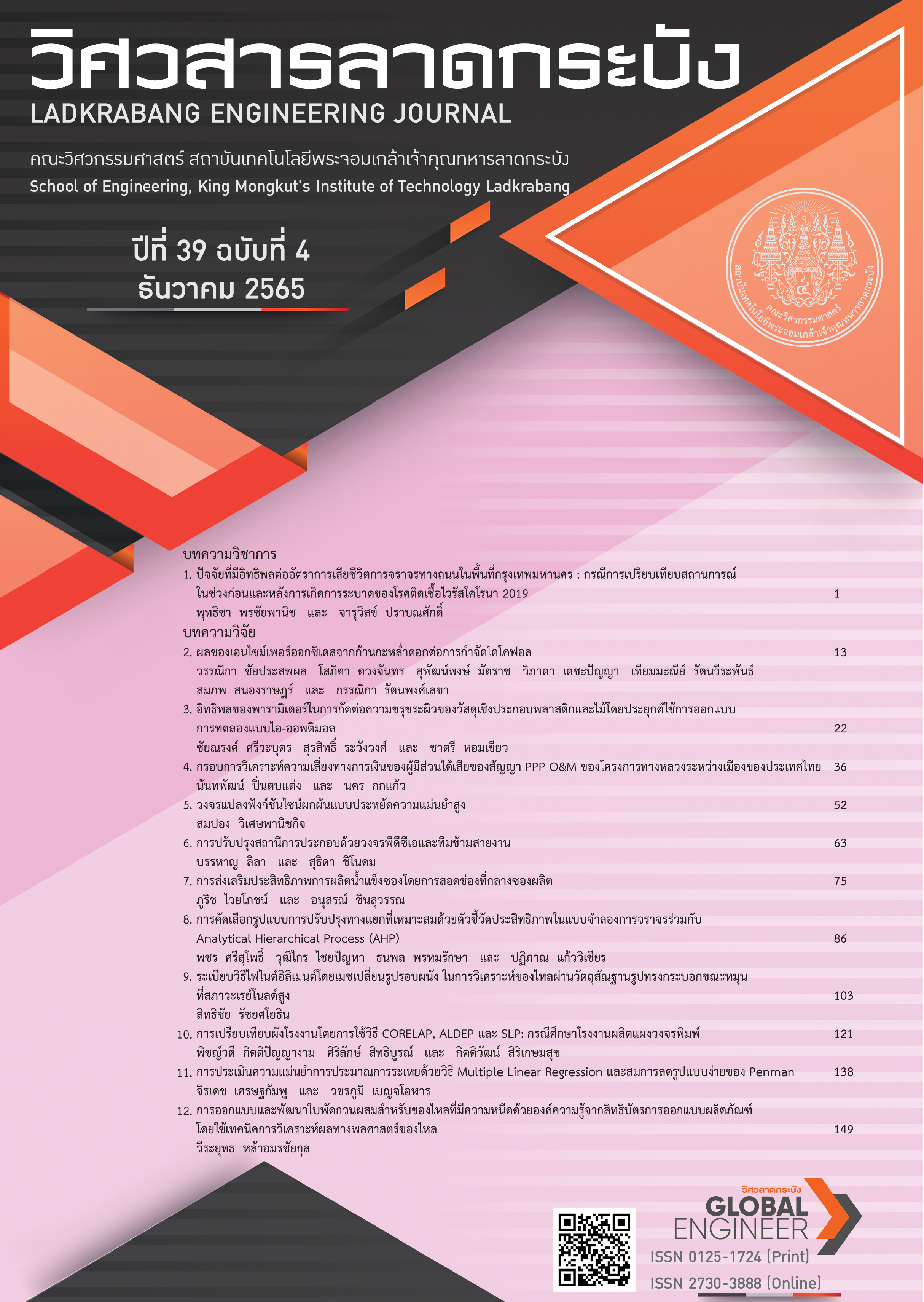การคัดเลือกรูปแบบการปรับปรุงทางแยกที่เหมาะสมด้วยตัวชี้วัดประสิทธิภาพในแบบจำลองการจราจรร่วมกับ Analytical Hierarchical Process (AHP)
คำสำคัญ:
ทางแยก, แบบจำลองการจราจร, Analytical Hierarchy Process (AHP)บทคัดย่อ
การศึกษานี้มีวัตถุประสงค์เพื่อคัดเลือกรูปแบบทางแยกที่เหมาะสมบริเวณจุดตัดโครงการก่อสร้างทางหลวงชนบท มห.4040 กับทางหลวงแผ่นดินหมายเลข 12 ด้วยตัวชี้วัดประสิทธิภาพจากแบบจำลองการจราจรร่วมกับ Analytical Hierarchical Process (AHP) ผลการศึกษาพบว่า ผู้เชี่ยวชาญให้ค่าน้ำหนักด้านวิศวกรรมจราจรสูงที่สุด (0.5327) รองลงมาคือด้านผลกระทบสิ่งแวดล้อม (0.2482) และด้านเศรฐศาสตร์ (0.2191) ตามลำดับ โดยความล่าช้าบริเวณทางแยกเป็นปัจจัยรองที่มีค่าน้ำหนักความสำคัญสูงสุด (0.2278) ผลการให้คะแนนสรุปว่ารูปแบบทางเลือกที่ 2 สะพานข้ามทางแยกตามแนว ทล.12 เป็นรูปแบบที่มีความเหมาะสมสูงสุดซึ่งได้ค่าคะแนน 0.9736 หรือ 97.36% โดยมีความโดดเด่นในปัจจัยวิศวกรรมจราจรและราคาค่าก่อสร้าง แต่มีข้อด้อยในปัจจัยด้านการใช้น้ำมันเชื้อเพลิงและผลกระทบสิ่งแวดล้อมซึ่งเป็นรองรูปแบบทางเลือกที่ 3 และ 4 ทั้งนี้ผลการศึกษาแสดงให้เห็นว่าตัวชี้วัดประสิทธิภาพจากแบบจำลองที่ใช้เป็นค่าตัวคูณของทุกปัจจัยสามารถให้ผลการคำนวณที่สมเหตุสมผล ตัดปัจจัยเชิงคุณภาพ ลดความยุ่งยากในการสำรวจ รวบรวมข้อมูล และการคำนวณ รวมทั้งจะเป็นอีกทางเลือกในการพิจารณาตัดสินใจคัดเลือกรูปแบบทางแยกต่อไป
References
Transport data and statistics–Office of Mukdahan land transport, Jun 20, 2022. [Online]. Available: https://www.dlt.go.th/site/mukdahan/m-news/11533/view.php?did=34250 (accessed Jun. 20, 2022).
Average annual daily traffic (AADT)–Open Government Data of Thailand, Jun 20, 2022. [Online]. Available: https://data.go.th/dataset/aadt64
Department of Rural Road (DRR). “Report on survey results and analyze data for forecasting traffic volumes, Survey Detailed Design and Environmental Impact Assessment (IEE) for the road construction of the principle city plan, Route NG.2 and NG.3 Road, Mukdahan principle city plan”, DRR., Bangkok, Thailand. 2009,
T. L. Saaty, “The analytic hierarchy process,” in The analytic hierarchy process: planning, priority setting, resource allocation. New York, NY, USA: McGraw-Hill International Book Co., 1980, ch. 1, sec. 1, pp. 3–34.
T. L. Saaty, “Decision making with the analytic hierarchy process,” International Journal of Services Sciences, vol. 1, no. 1, pp. 83–98, 2008, doi: 10.1504/IJSSCI.2008.017590.
K. Wunderlich, M. Vasudevan and P. Wang, “TAT Volume III: Guidelines for Applying Traffic Microsimulation Modeling Software 2019 Update to the 2004 Version,” U.S. Department of Transportation Federal Highway Administration, Washington, DC, USA, Rep. FHWA-HOP-18-036, 2019.
W. Burghout, H. Koutsopoulos, and I. Andréasson, “Hybrid Mesoscopic-Microscopic Traffic Simulation,” Transportation Research Record: Journal of the Transportation Research Board, vol. 1934, no. 1, pp. 218–255, 2005, doi: 10.3141/1934-23.
The Institution of Highways & Transportation, “Traffic microsimulation modeling,” Network Management Notes, pp. 1–4, 2006. [Online]. Available: https://www.ciht.org.uk/media/4365/traffic_microsimulation_modelling.pdf
T. Kojima, A. Fukuda, T. Ishizaka and P. Luathep, “Study on the Evaluation of the Roundabout Utilizing Micro Traffic Simulation Model” in 7th ATRANS Symposium: Young Researcher's Forum, Bangkok, Thailand, Aug. 22, 2014, pp. 242–247.
P. Warasak, S. Thanet, S. Wichuda and D. Atthaphon, “Analysis of traffic management for motorcycles at traffic signal junctions,” in proceeding the 18th National Civil Engineering Conference, Chiang Mai. Thailand, May 8–10, 2013, pp. TRP 236–TRP 242.
Y. Chaiwat and L. Paramet, “An Analysis of Traffic Management of Multiple Consecutive Intersections: A Case Study of Hat Yai Municipality,” Journal of Engineering and Innovation, vol. 8, no. 1, pp. 103–114, 2015.
R. Chayada and K. Noppadol, “Energy and Environmental Assessment for Intersection Design Control in University Campus,” in proceeding the 25th National Civil Engineering Conference, Chonburi, Thailand, Jul. 15–17, 2020, pp. ENV051–ENV059.
K. Wanwisa and P. Jumrus, “Traffic Operational Analysis of Continuous Flow Urban Interchange Using Micro Simulation Modeling Technique :A CaseStudy of Dat Daruni School, Chachoengsao,” Ladkrabang Engineering Journal, vol. 35, no. 1, pp. 23–32, 2018.
W. Muanmas, H. Phongtorn and S. Sittiwat, “Recommendation for improvement of traffic circulation during Kaset fair,” Ladkrabang Engineering Journal, vol. 33, no. 1, pp. 72–77, 2016.
Department of Rural Road (DRR). Survey project designed to solve traffic problems at the intersection on CR.5023, Rob Wiang Subdistrict, Mueang District, Chiang Rai Province.”.,DRR. BKK, Thailand. 2019,
P. Thanapol, S. Thaned and S. Wichuda, “Vehicle actuated signal control for low carbon society,” International Journal of GEOMATE, vol. 16, no. 55, pp. 56–91, 2019, doi: 10.21660/2019.55.4766.
J. A. Gómez Romero, R. Soto Flores and S. Garduño Román, “Determination of the Weightings of HydroelectricSustainability Criteria by Combining AHP and GP Extended Methods,” Ingeniería, vol. 24, no. 2, pp. 116–142, 2019, doi: 10.14483/23448393.14469.
J. Greenbaum, “A design of one's own: Towards participatory design in the United States”. in Participatory Design, D. Schuler and A. Namioka Eds., Hillsdale, NJ, USA: Lawrence Erlbaum, 1993, ch. 3, pp. 27–37.
M. G. Melón, P. A. Beltran and M. C. G. Cruz, “An AHP-based evaluation procedure for Innovative Educational Projects: A face-to-face vs. computer-mediated case study,” Omega, vol. 36, no. 5, pp. 754–765, 2008, doi: 10.1016/j.omega.2006.01.005.
Ewing R, “Traffic Calming: State of the practice,” Institute of Transportation Engineering, Washington D. C., USA, 1999.
Protocol for Vissim Simulation, Washington State Department of Transportation, Olympia, WA, USA, 2014, pp. 13–21.
VISSIM 6 User manual, PTV AG., Karlsruhe, Germany, 2014.
W. Tony, “Calibrating Freeway Simulation Models In Vissim,” M.S. Thesis, Dept. Civil Engineering, Washington Univ., Seattle, WA, USA, 2006.
B. (Brian) Park and J. D. Schneeberger, “Microscopic Simulation Model Calibration and Validation: Case Study of VISSIM Simulation Model for a Coordinated Actuated Signal System,” Transportation Research Record: Journal of the Transportation Research Board, vol. 1856, no. 1, pp. 185–192, 2003, doi: 10.3141/1856-20.
S. Somkane, “Factor Priority Analysis used in considering the improvement of the Department of Highways for the improvement of the junction by hierarchical analysis process,” M.E. Thesis, Dept. Engineering and Construction Management, King Mongkut's University of Technology Thonburi, Bangkok, Thailand, 2005.
S. Nantawan, V. Chavalek and K. Aswin, “Evaluation of appropriate configurations for urban-grade separation intersections, a case study : Khae Rai intersection-highway 302 (Rattanathibet Road) and highway 306 (Tivanon Road),” Kasetsart Engineering Journal, vol. 22, no. 70, pp. 57–69, 2010.
M. Worawit and T. Kittichai, “A Study of Appropriate Configurations for Rural Service Interchange A Case Study of Highway No. 35 (Rama II Road) and Rural Road 2055 Interchange,” Technical Education Journal King Mongkut’s University of Technology North Bangkok, vol. 12, no. 3, pp. 34–46, 2021.
Downloads
เผยแพร่แล้ว
How to Cite
ฉบับ
บท
License
Copyright (c) 2022 คณะวิศวกรรมศาสตร์ สถาบันเทคโนโลยีพระจอมเกล้าเจ้าคุณทหาร

This work is licensed under a Creative Commons Attribution-NonCommercial-NoDerivatives 4.0 International License.
บทความที่ได้รับการตีพิมพ์เป็นลิขสิทธิ์ของคณะวิศวกรรมศาสตร์ สถาบันเทคโนโลยีพระจอมเกล้าเจ้าคุณทหารลาดกระบัง
ข้อความที่ปรากฏในบทความแต่ละเรื่องในวารสารวิชาการเล่มนี้เป็นความคิดเห็นส่วนตัวของผู้เขียนแต่ละท่านไม่เกี่ยวข้องกับสถาบันเทคโนโลยีพระจอมเกล้าเจ้าคุณทหารลาดกระบัง และคณาจารย์ท่านอื่นๆในสถาบันฯ แต่อย่างใด ความรับผิดชอบองค์ประกอบทั้งหมดของบทความแต่ละเรื่องเป็นของผู้เขียนแต่ละท่าน หากมีความผิดพลาดใดๆ ผู้เขียนแต่ละท่านจะรับผิดชอบบทความของตนเองแต่ผู้เดียว






